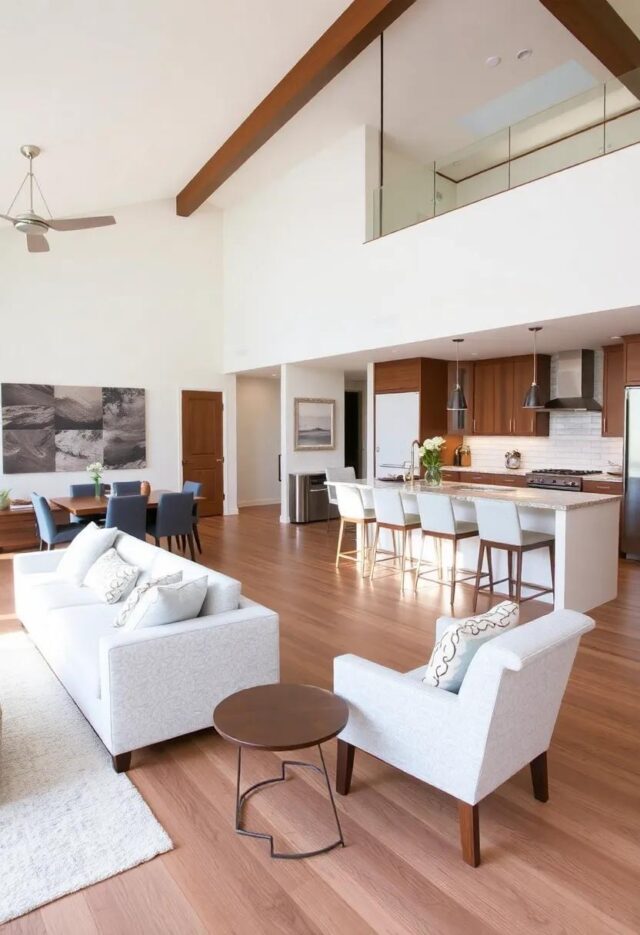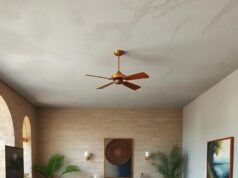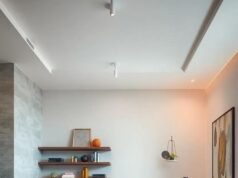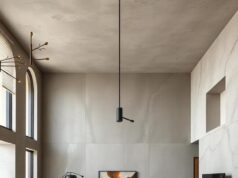In the realm of modern home design, the concept of open living spaces has emerged as a defining trend, inviting an unparalleled sense of freedom and connection within our everyday environments. The allure of combining the living room and kitchen into a cohesive, flowing area not only enhances functionality but also cultivates a warm, inviting atmosphere where family and friends can gather effortlessly. As the heart of the home, this integrated space celebrates the beauty of interaction and togetherness. Adding to this dynamic is the timeless charm of wood flooring, which infuses natural warmth and texture, bridging the aesthetic with the practical. In this article, we will explore the enchanting benefits of an open concept living room and kitchen adorned with wood flooring, highlighting its ability to transform a house into a true sanctuary of harmony and comfort. Whether you are considering a renovation or simply dream of an ideal space, join us in discovering how these elements harmonize to create the perfect backdrop for modern living.
Embracing the Open Concept: A Seamless Connection Between Living and dining Spaces
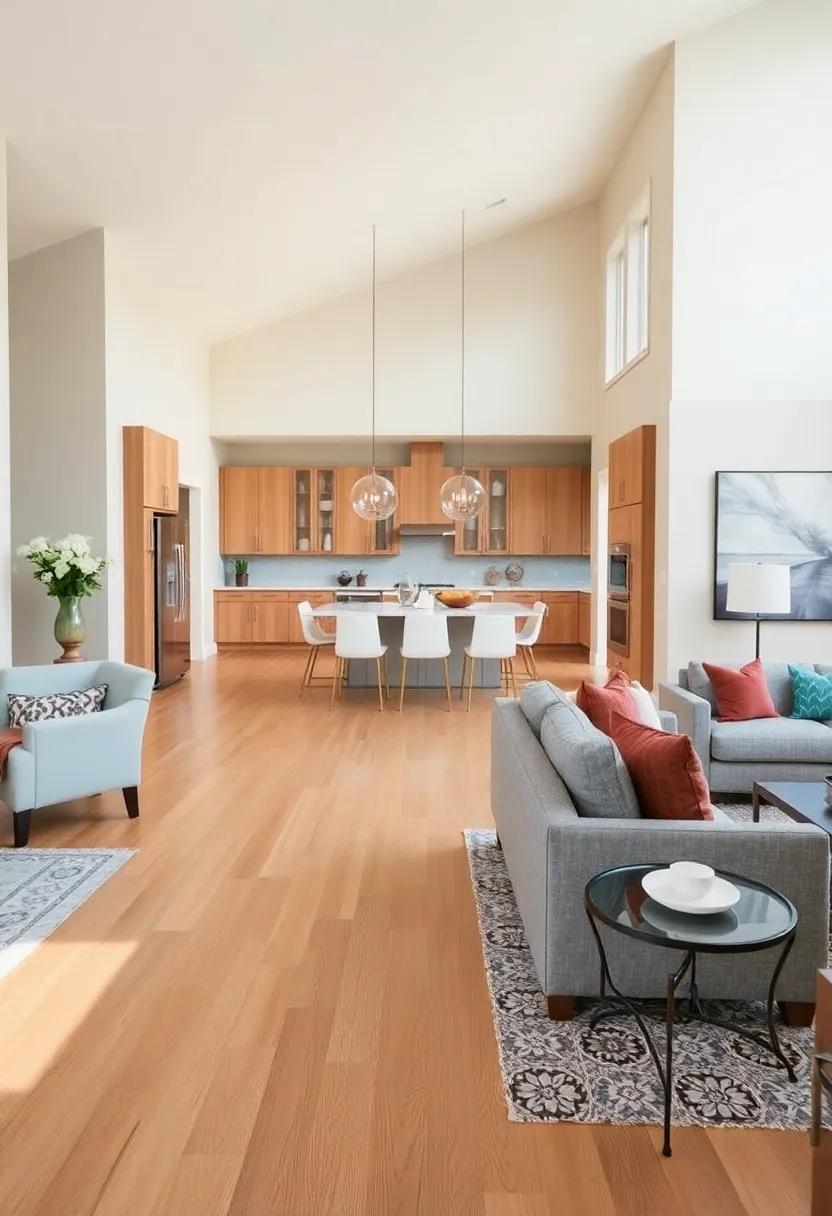
In the contemporary home, the shift towards an open layout fosters a sense of connectivity and flow, allowing different areas to interact seamlessly. With wood flooring as a unifying feature, the transition between living and dining spaces becomes virtually effortless. wood not only enhances the aesthetic appeal but also adds warmth and a timeless quality to the home. The gentle hues and natural textures of wooden floors create a versatile backdrop that complements various decor styles, encouraging a harmonious blend of functionality and beauty. Here are some key benefits of this design approach:
- Enhanced natural Light: Open spaces maximize light flow, making areas feel brighter and more inviting.
- Improved Social Interaction: Removing barriers fosters dialog and interaction, perfect for gatherings.
- Versatile Design: An open layout allows for a cohesive design vision across different zones.
- efficient space Utilization: eliminating walls often creates more usable space for activities and furniture.
To further accentuate the allure of open concept living, consider incorporating multi-functional furniture that adapts to your needs throughout the day. A stylish dining table can double as workspace during the day, while plush seating options in the living area provide comfort without compromising style. Investing in thoughtful decor elements will elevate the overall ambiance.Below is a simple comparison of popular wood flooring options:
| Wood Type | Durability | Characteristic |
|---|---|---|
| Oak | High | Classic look, strong grain |
| Bamboo | Moderate | Eco-friendly, sleek appearance |
| Maple | High | Light color, smooth texture |
| Walnut | Moderate | Rich color, luxurious appeal |
Wood Flooring: The Perfect Foundation for Open Concept Elegance
The natural warmth and richness of wood flooring create an inviting atmosphere that seamlessly connects the living room and kitchen. This type of flooring not only enhances the aesthetic appeal but also provides a cohesive visual flow throughout the open spaces.With its versatile design, wood can complement various interior styles, from rustic to modern chic. Homeowners can choose from a variety of species—like oak, maple, or walnut—each bringing its unique character and depth to the overall decor.
Incorporating wood flooring into your open concept layout not only elevates the style but also promotes a sense of unity between spaces. Here are some reasons why wood flooring is an excellent choice:
- Timeless Appeal: Wood flooring never goes out of style and can adapt to changing trends.
- Durability: With proper care, wood floors can last for decades, making them a wise investment.
- Easy Maintenance: Regular sweeping and occasional refinishing maintain their beauty over time.
Natural Light: Enhancing the Atmosphere in Open Living Areas
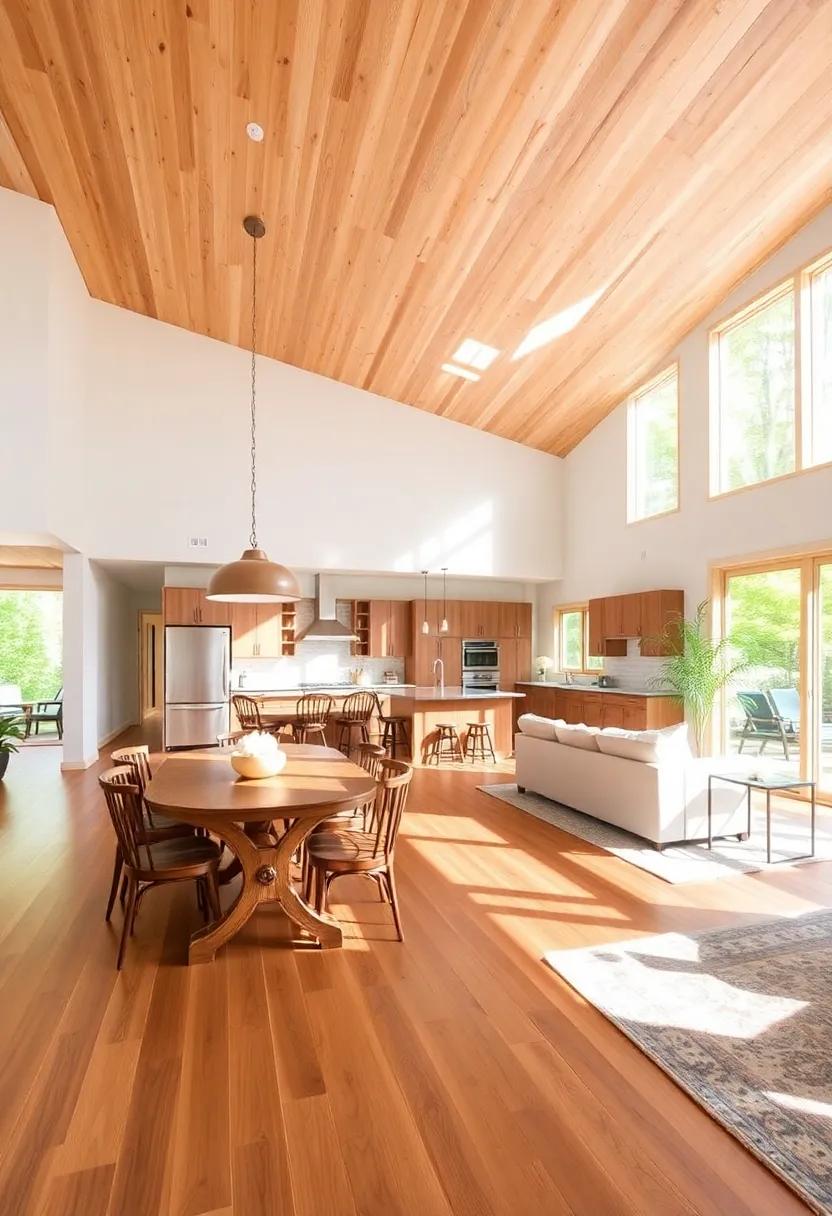
Natural light plays an invaluable role in defining the atmosphere of open living areas, creating a serene and inviting environment. with expansive spaces that seamlessly blend the kitchen and living room, abundant sunlight enhances the warmth of wood flooring, accentuating its rich textures and hues. Incorporating large windows or skylights not only floods these areas with light but also connects the indoors with the vibrant rhythms of nature outside. The soft, diffused sunlight throughout the day creates a dynamic interplay of shadows and highlights, transforming the space and making it feel alive.
To maximize the benefits of natural light in your open concept design, consider the following elements:
- Window Placement: Opt for strategically placed windows to capture sunlight at different times of the day.
- light Curtains: Use sheer curtains that allow light to filter in while maintaining privacy.
- Reflective Surfaces: Incorporate mirrors or glossy finishes to bounce light around the room, enhancing brightness.
- Color Palette: Choose lighter paint colors for walls to create an airy feel that complements the natural light.
| Feature | Benefit |
|---|---|
| Large Windows | Optimizes daylight and views |
| Skylights | Increases brightness in smaller spaces |
| Transom Windows | Adds height and architectural interest |
| Light-colored Floors | Reflects more light, enhancing warmth |
Creating Visual Balance: Harmonizing Kitchen and Living Room Design
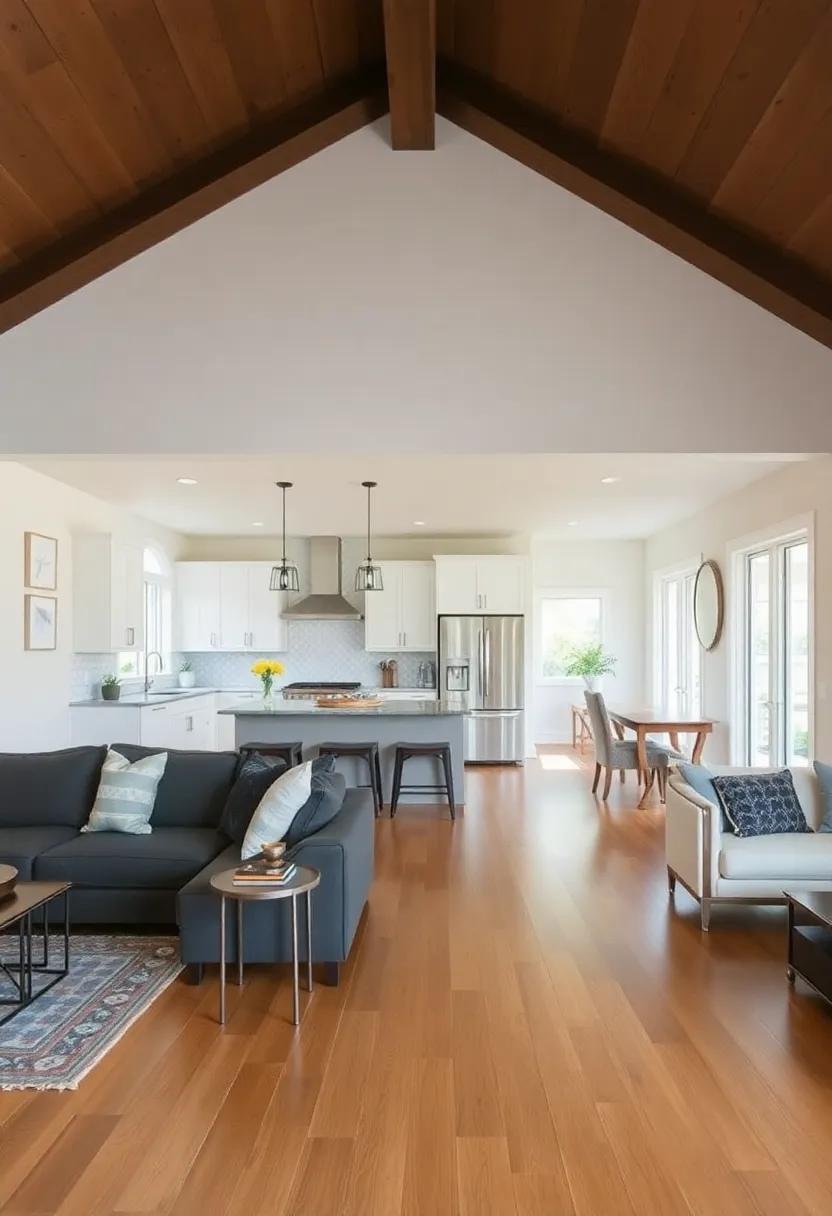
Achieving a seamless transition between the kitchen and living room is essential for creating a visually harmonious space. Color palettes play a vital role, with neutral tones and earthy hues being especially effective in establishing continuity. When incorporating wood flooring, consider the following design elements to further enhance balance:
- Consistent Wood Grain: Choose wood finishes that maintain a similar grain pattern throughout the rooms.
- Integrated Lighting: Use similar light fixtures to connect the areas while providing adequate illumination.
- Flowing Textures: Mix materials like soft textiles in the living area and sleek surfaces in the kitchen for a cohesive feel.
Along with color and texture, the furniture layout should facilitate a smooth transition between zones. Open spaces allow for interaction while maintaining individual functions. Consider the placement of items such as:
| Living Room | Kitchen |
|---|---|
| Sectional sofa or chairs facing the kitchen | Bar stools at a kitchen island |
| Coffee table with decorative elements | Stylish dinnerware displayed on open shelves |
| Plants or artwork for decoration | Herbs or small plants in pots on windowsills |
Color Palette Choices: Uniting Spaces Through Thoughtful Color Schemes
When it comes to designing an open concept living room and kitchen, the color palette plays a crucial role in creating an inviting and cohesive space.Thoughtful choices in hues can unite the two areas, allowing them to flow seamlessly into one another. Consider selecting a color scheme that emphasizes the warm undertones of wood flooring.Shades like muted taupe or soft beige can enhance the natural grain of the wood, while cooler accents like teal or muted blue can provide a fresh contrast. Incorporating these key colors can create an atmosphere of harmony and sophistication, turning your open space into a visual masterpiece.
Beyond the primary colors, accent hues can serve as delightful focal points throughout the living and kitchen areas. Using decorative elements like pillows, artwork, and kitchen accessories in complementary shades helps reinforce the overall aesthetic. Here are a few effective combinations to consider:
- Soft Gray & Deep Navy: A modern yet timeless palette.
- Burnt Orange & Cream: Warm, inviting, perfect for a cozy feel.
- Olive Green & Warm White: A natural and earthy combination.
- Pale Pink & Charcoal: A chic and trendy contrast.
Utilizing a well-curated color palette creates a sense of connection throughout the open spaces. By balancing neutral tones with vibrant accents, you can achieve a look that exudes warmth and character. Whether it’s through the choice of paint, furnishings, or decorative details, each element plays a part in crafting an environment that feels both complete and welcoming.
The Role of Textures: adding Depth in Open Concept Environments
Textures play a pivotal role in crafting an inviting atmosphere within open concept living spaces,where the seamless fusion of room elements demands a careful balance of visual interest and cohesiveness. Wood flooring, with its natural grains and hues, serves as a solid foundation that complements various textures found throughout the environment. By incorporating soft fabrics, smooth ceramics, and rustic metals, homeowners can create a dialogue between these contrasting materials, allowing the eye to travel effortlessly across the space while enhancing the warm tones offered by the hardwood. This interplay not only enriches the aesthetic appeal but also fosters an intuitive flow that makes the area feel spacious and interconnected.
To maximize the harmonious interaction of textures, it’s essential to consider layering and placement strategically.Here are some effective ways to achieve depth:
- Textured Cushions: Use a mix of materials like velvet and linen to encourage tactile exploration.
- Accent Rugs: introduce varied patterns beneath furniture to create distinct zones without breaking the visual continuity.
- Wall Treatments: Incorporate wood paneling or textured paint in select areas to enhance vertical depth.
In addition,the use of accessories such as woven baskets or ceramic vases can serve as focal points,effortlessly drawing attention to their unique surfaces while contributing to the overall harmony of the space. This careful curation of elements not only adds character but also invites guests to experience a comfortable yet dynamic setting that encapsulates the essence of modern open concept living.
Multipurpose Furniture: Maximizing Functionality Without Sacrificing Style
In the realm of modern design, the partnership between sensation and utility shines brightly through the concept of multipurpose furniture. Imagine a coffee table that transforms into a workspace at a moment’s notice or a chic ottoman that doubles as extra seating and storage. These versatile pieces not only maximize the efficiency of your space, but they also contribute to a cohesive aesthetic. With an array of finishes and styles available,you can choose options that complement your open-concept living area,seamlessly integrating into your design while enhancing functionality.Consider investing in items like:
- Convertible sofas that adapt to your space needs
- Wall-mounted drop-leaf tables perfect for dining or working
- Storage benches that serve as both seating and hidden organizers
Moreover, when merging an open concept living room and kitchen with elegant wood flooring, multipurpose furniture helps maintain an airy feel while providing necessary conveniences. The natural warmth of wooden floors can be beautifully paired with sleek,modern pieces,creating a harmonious palette that feels both inviting and stylish. By strategically placing multipurpose furniture, you can define specific areas for relaxation, dining, or socializing, effectively guiding the flow of movement through the space. As you curate your furnishings, think about how each piece can enhance the overall experience, from:
| Furniture Type | Functionality |
|---|---|
| Nested Tables | Space-saving and adaptable for gatherings |
| Murphy Beds | Transforms a living area into a guest room |
| Bookshelf Dividers | Creates distinct zones while providing storage |
Zone Differentiation: Unifying Yet Distinct Areas in Open Designs
In open concept designs,zoning is essential for creating an atmosphere that feels cohesive while retaining unique characteristics within each area. Achieving this balance often involves employing various design strategies that emphasize function without sacrificing aesthetics. Consider using area rugs to delineate the living space from the kitchen, providing warmth and textural contrast. Furniture placement can also serve as a natural divider, guiding the flow of movement while keeping both areas connected. Elements such as differing color palettes or wall treatments can further enhance the sense of separation, allowing each zone to express its distinct personality while still resonating with the overall theme of the home.
Incorporating wood flooring throughout these zones creates a seamless transition between the living room and kitchen,amplifying the sense of harmony. The choice of wood can influence the atmosphere drastically; lighter woods can evoke a fresh, airy vibe, while darker tones add warmth and intimacy. When layered with complementary furnishings and decor, these design elements can promote a unified aesthetic. Below is a concise comparison of how different wood types can enhance various moods in open spaces:
| Wood Type | Mood Created |
|---|---|
| oak | Timeless and warm |
| Bamboo | Eco-friendly and modern |
| Cherry | Rich and elegant |
| pine | Rustic and inviting |
Incorporating Nature: Bringing the Outdoors In with Open Spaces
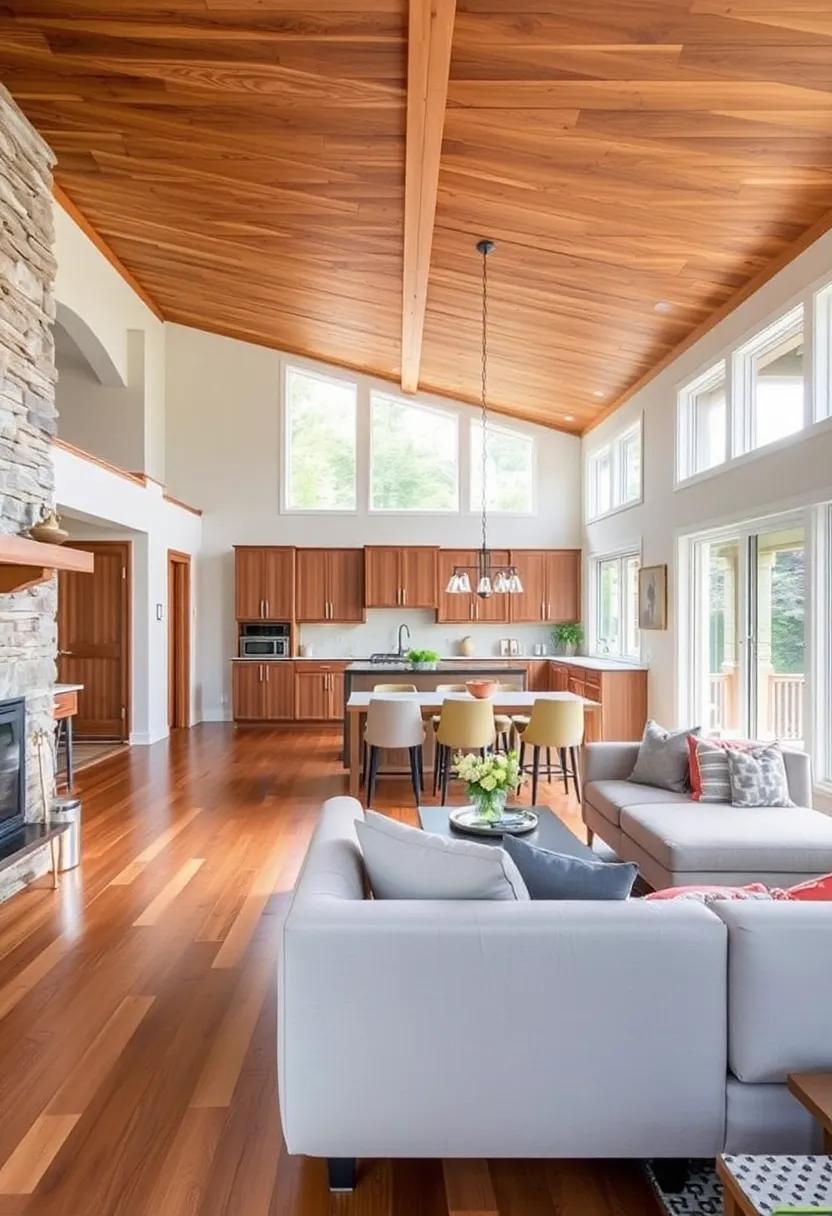
Incorporating the essence of the outdoors into your living space creates a profound sense of tranquility and connection with nature. open spaces that blend the living room and kitchen allow for a seamless flow, where light and air dance freely throughout the area. Imagine the gentle hues of natural wood flooring, which evoke warmth and complement the rich palette of the outside world. To enhance this harmonious blend, consider integrating elements such as:
- Large Windows: invite sunlight and stunning views to flood in.
- Indoor Plants: Add vibrant greenery that purifies air and elevates mood.
- Nature-Inspired Decor: Use artwork and textiles that echo outdoor landscapes.
Moreover, choosing a color scheme that reflects the natural world can create an immersive experience. Earthy tones such as greens, browns, and soft sands can serve as the backdrop for the lively chatter of family and friends, uniting the energetic essence of cooking with the soothing ambiance of relaxation. Consider utilizing this simple table for further insights on incorporating nature into your design:
| Design Element | nature-Inspired Benefits |
|---|---|
| Natural Lighting | Enhances mood and reduces energy costs. |
| Wood flooring | Creates warmth and grounds the space. |
| Indoor Greenery | Improves air quality and brings life indoors. |
Sustainable Choices: Eco-Friendly materials for Modern Living
In today’s world, where sustainability has become a cornerstone of modern living, selecting the right materials is crucial. Wood flooring, particularly from responsibly managed forests, exemplifies eco-friendliness. Not only does it provide an inviting warmth to your open concept living spaces, but it also contributes to indoor air quality by naturally regulating humidity. With a myriad of choices available, consider varieties like bamboo, which is a rapidly renewable resource, or reclaimed wood, offering both character and environmental benefits.
Incorporating such materials into your design not only enhances aesthetics but also promotes a healthier planet. Look for finishes and adhesives free from harmful chemicals to further reduce your carbon footprint. When exploring options, consider how these materials create a cohesive flow between living and dining areas:
- Durability: Wood flooring is long-lasting, reducing the need for replacements.
- Insulation: It provides natural insulation,maintaining energy efficiency.
- Versatility: Complements various styles, from rustic to contemporary.
Focal Points: Designing Eye-Catching Features in Open Room Layouts
In an open concept living room and kitchen, the lack of physical barriers offers a unique chance to create visual focal points that enhance both style and functionality. Accent walls painted in bold colors or adorned with striking wallpaper can draw the eye and provide a stunning backdrop for furniture arrangements. Consider statement lighting fixtures—like oversized pendant lights or sculptural chandeliers—that not only illuminate but also serve as artistic elements that define the space. Incorporating features such as a dramatic island in the kitchen with contrasting materials can also make the area feel inviting,turning everyday cooking into a stylish experience.
To achieve a harmonious blend of aesthetics and practicality, various elements can complement one another. Natural materials, such as wood flooring, seamlessly tie the spaces together, while textured textiles in the living area add warmth and comfort, inviting social interaction. Including strategically placed plant arrangements or decorative shelves with curated books and knick-knacks can also create vertical interest and character in the design. to illustrate these concepts, here’s a table showcasing some effective focal point ideas and their intended impacts:
| Feature | Impact |
|---|---|
| Accent wall | Defines space and adds depth |
| Statement Lighting | Enhances ambiance and visual appeal |
| Kitchen Island | Creates a central gathering place |
| Textured Textiles | Adds warmth and invites relaxation |
| Plants | Brings life and freshness to the design |
Creating Warmth: The Comfort of Wood Underfoot in Open Living Areas

In open living spaces, where the boundaries between kitchen and living room blur, the choice of flooring plays a crucial role in shaping the atmosphere. Opting for wood flooring not only enhances the aesthetic appeal but also invites unmatchable warmth and comfort.The natural tones of wood can create a cozy ambiance, making both areas feel interconnected while promoting a sense of relaxation. Each step on a wooden surface satisfies with its soft touch and suggests a welcoming retreat, encouraging family interactions and gatherings without the harshness of colder materials.
Additionally, wood flooring offers versatile design possibilities, seamlessly blending with various decor styles—from rustic charm to modern elegance. With a variety of finishes available, homeowners can easily customize their space to reflect personal tastes. Some benefits of incorporating wood flooring include:
- Timeless appeal: Wood never goes out of style, enhancing both classic and contemporary environments.
- Insulation properties: Wood naturally retains warmth, reducing energy costs and enhancing comfort.
- Durability: With proper maintenance, wood floors can withstand heavy foot traffic while adding to the home’s value.
| Wood Type | Benefits |
|---|---|
| Oak | Strength and resistance to wear |
| Maple | Light color enhances bright spaces |
| Walnut | rich tones for luxurious feel |
Visual Flow: Ensuring Smooth Transitions Between Kitchen and Living Room
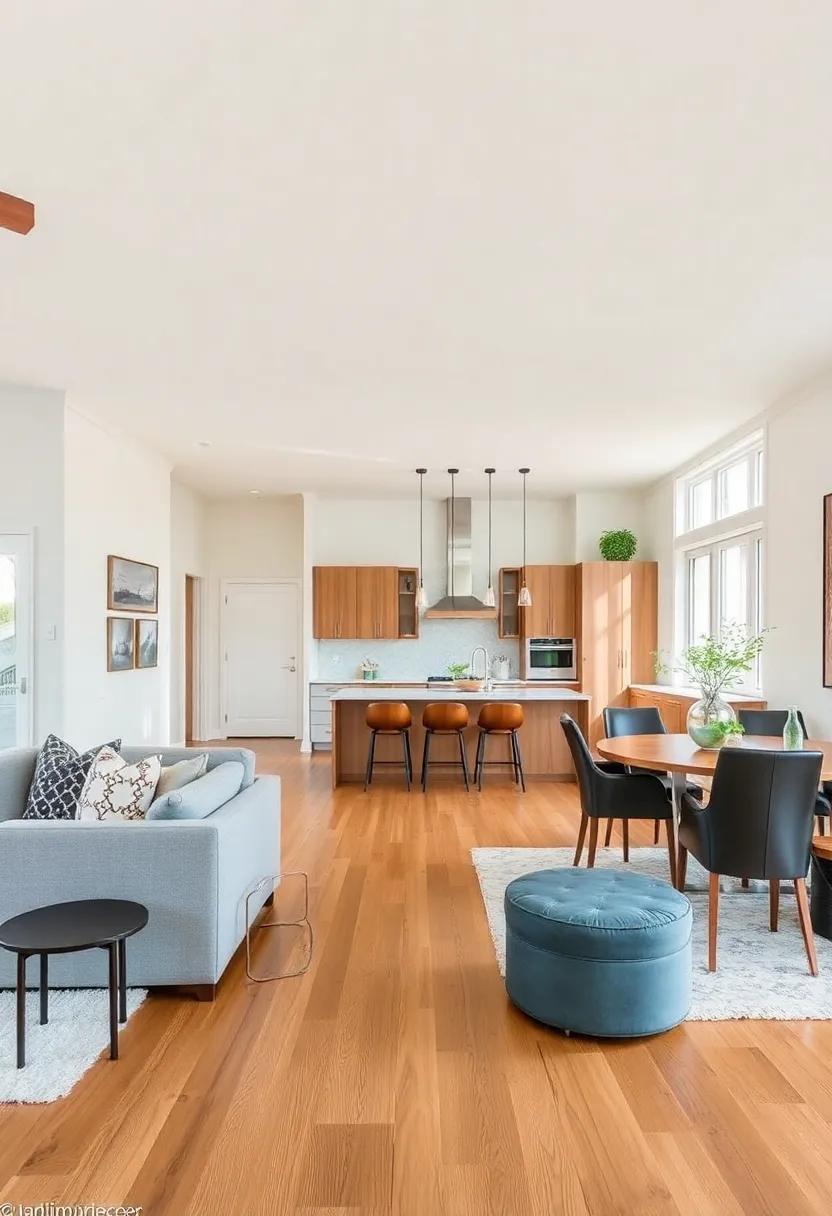
The seamless integration of the kitchen and living room is not merely a trend; it’s a lifestyle choice that enhances the functional and aesthetic aspects of your home.To create a sense of continuity, consider adopting a cohesive color palette that seamlessly links both spaces. Soft neutrals and earthy tones can act as a backdrop, while accent colors can be introduced through decor and fixtures.Additionally, utilizing the same type of wood flooring in both areas can provide a unified look that enhances flow and invites natural movement throughout the spaces. The warmth of wood not only adds charm but also provides an inviting ambiance that encourages intimacy in gatherings.
To further elevate visual flow, strategically position furniture to promote open sightlines. Here are a few tips to consider:
- Low-profile furniture can reduce visual obstruction.
- Incorporate multi-functional pieces that can bridge the gap between the two areas.
- Use area rugs to define spaces while maintaining openness.
- Open shelving in the kitchen can display dishware that complements living room decor.
Creating a harmonious connection between the kitchen and living room transforms the home into a vibrant gathering space, where every transition feels effortless and every moment is infused with comfort.
Statement Lighting: illuminating Open spaces with Style and Function
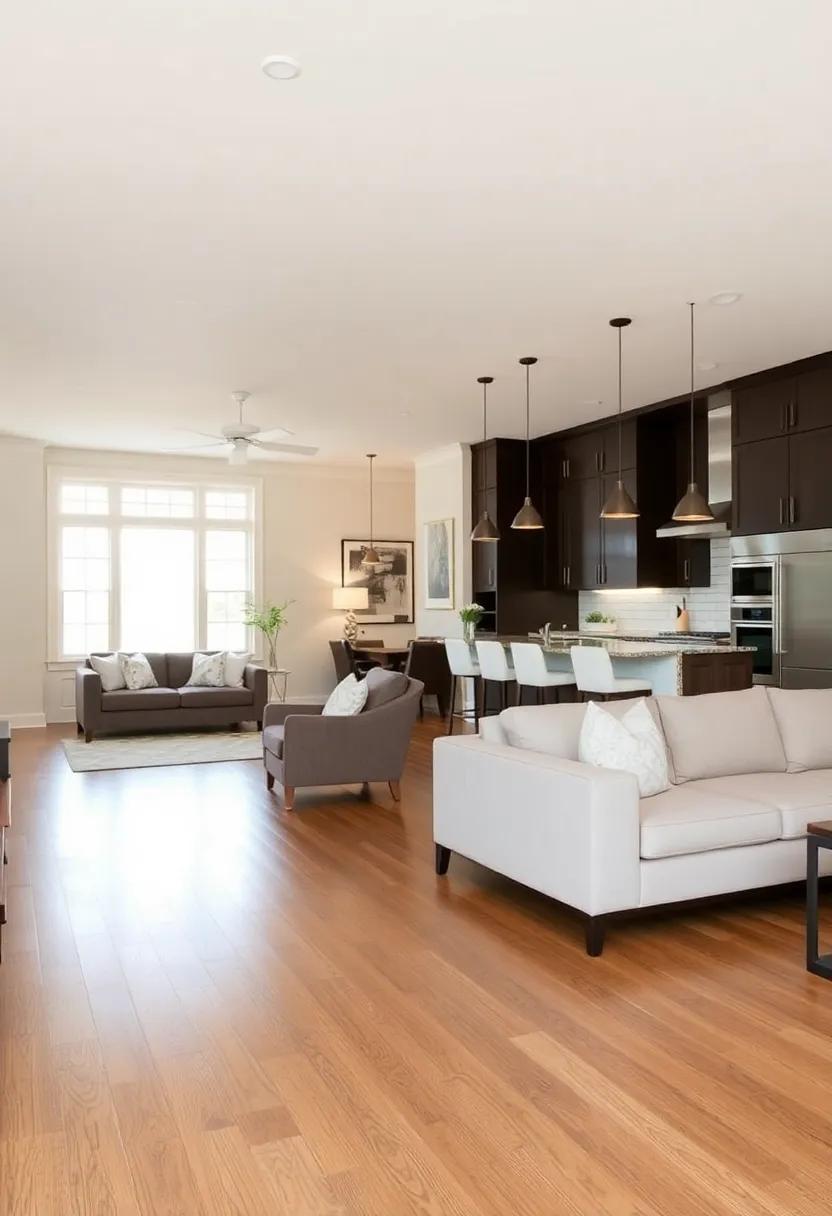
In the realm of open spaces,statement lighting transcends mere functionality,transforming the atmosphere while accentuating architectural elements. A carefully chosen pendant light or a striking chandelier can serve as a bold focal point, drawing the eye upward and creating a sense of volume in an expansive living area. this technique not only enhances visual interest but also harmonizes the organic warmth of wood flooring with the sleek modernity of open-concept design.Consider these captivating lighting options:
- Multi-tiered chandeliers: Perfect for adding drama and sophistication.
- Bold sculptural fixtures: Serve as art pieces themselves, enhancing the aesthetic.
- Adjustable track lighting: Offers versatility and can highlight different areas.
The placement of lighting in open spaces is equally crucial. Incorporating fixtures that deliver both direct and ambient light can make the room inviting and functional. For example, layering warm overhead lights with softer, strategically placed lamps can nurture a cozy ambience ideal for entertaining. Below is a quick guide for selecting the right lighting based on your space’s character:
| space type | Ideal Lighting | Style Elements |
|---|---|---|
| Living room | Statement Pendants | Artistic & Inviting |
| Kitchen | Task Lighting | Functional & Sleek |
| Dining Area | Chandeliers | Elegant & Cozy |
Artistic Arrangements: Showcasing personal Touch in Open Concept Living
In an open concept living space, the interplay between the kitchen and living room can be harmoniously accentuated through artistic arrangements. By combining color, texture, and form, you can create a personal touch that reflects your unique style. Consider incorporating items such as:
- Handmade pottery as accents on open shelving
- Custom artwork hung strategically to draw the eye
- Layered textiles like throw pillows and rugs that introduce warmth
Even with the vastness of open spaces, clever zoning can deliver a sense of intimacy.Using varying heights and shapes can create distinct areas for cooking, dining, and relaxing.For example, a central island can serve as a functional yet artistic focal point. Consider these components for a visually appealing setup:
| Element | Effect |
|---|---|
| Decorative Lighting | Creates ambiance and highlights architecture |
| Open Shelving | Showcases personal collections, adding character |
| Accent Walls | Defines spaces while adding visual interest |
Creating Inviting Spaces: The Allure of Cozy Corners in Large Areas

In the vast expanse of open-concept living, the integration of cozy corners can transform an or else sprawling area into a haven of warmth and relaxation. These intimate nooks, whether adorned with plush armchairs, handmade quilts, or carefully curated bookshelves, serve as inviting retreats amidst the hustle and bustle of modern life. By strategically placing elements that evoke comfort and personal touch, large areas can maintain their spacious appeal while offering distinct spaces for unwinding and reflection.
consider incorporating features like soft lighting, woven textures, and vibrant greenery to create a harmonious balance with the surrounding open areas. You might find that the addition of a small coffee table or a decorative rug can delineate these cozy enclaves, providing a sense of belonging within the larger context. Here are some ideas to enhance the charm of your cozy corners:
- Layered Textures: Mix cushions, throws, and stylish fabrics.
- Personal Decor: Display family photos or favorite artwork.
- Natural Elements: Incorporate plants to add a touch of nature.
- Ambient Lighting: Use lamps and candles to create warmth.
Crafting Conversation Areas: Encouraging Social Interaction in Open Designs
Creating distinct conversation zones within your open concept space can transform how social interactions unfold. By using strategic furniture placement,rugs,and subtle lighting,you can delineate areas without sacrificing the openness that defines your living space. Consider the following elements to foster a warm and inviting atmosphere:
- Variation in seating: Incorporate a mix of chairs, sofas, and benches to encourage people to gather in smaller groups.
- Layered lighting: Use table lamps, pendant lights, and wall sconces to create intimacy and highlight specific areas.
- Textural inclusivity: Integrate various materials—soft throws, textured cushions, and natural elements—to make each zone feel cozy and welcoming.
Moreover, incorporating interactive elements invites engagement. A communal table with games can serve as a focal point for lighthearted interactions.Planting small greenery or using vibrant artwork can also provoke conversation and enhance the aesthetics of your environment. Consider these options when designing your space:
| Element | Purpose |
|---|---|
| Communal Table | Encourage game playing and shared meals |
| Comfortable Seating | Facilitate intimate conversations |
| Interactive Art | Stimulate discussion and creativity |
Personalized Decor: Infusing Character in Every Corner of Open Spaces
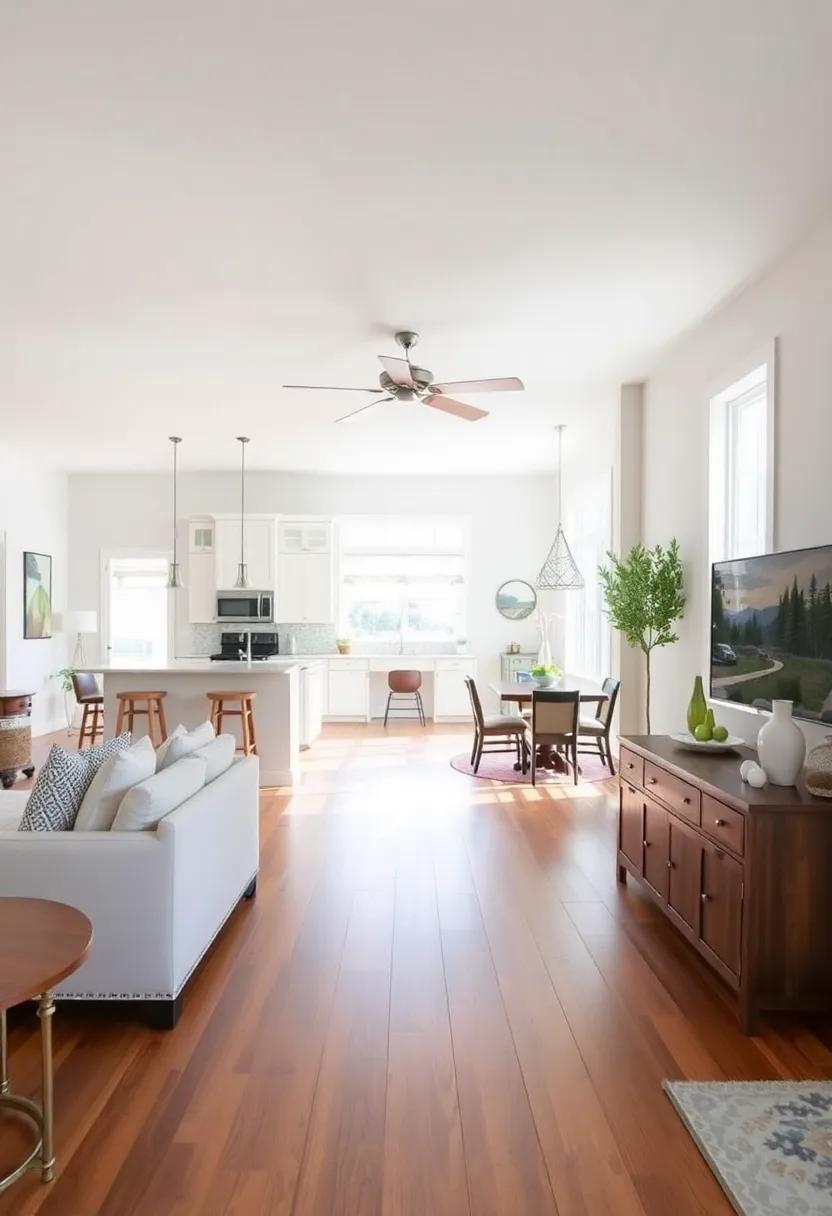
In the realm of open spaces, where breathability meets serenity, personalized decor emerges as a vital element to instill warmth and individuality.By integrating unique pieces that reflect personal stories and interests, each corner of your living room and kitchen can transform into a canvas of expression. Much like an artist chooses colors and strokes, consider the following elements:
- Artworks: Incorporate local art or family heirlooms that tell a story.
- Textures: Layer textiles—think of a cozy throw or vibrant cushions—to add depth.
- Plants: Introduce greenery; plants like succulents or herbs arrange naturally across surfaces.
- Lighting: Choose fixtures that echo your style, enhancing both ambiance and functionality.
Moreover, defining zones within the open space without losing coherence is essential. Utilize variations in decor elements to subtly divide the living room from the kitchen while maintaining a harmonious feel. One way to achieve this is by using furniture and decor in contrasting yet complementary styles. Consider a simple table like this:
| Style Element | Description |
|---|---|
| Accent Chairs | Bold colors to create a focal point in the living room. |
| Bar Stools | Minimalist wood designs to match the kitchen’s charm. |
| Wall Decor | Gallery wall of family photos bridging both spaces. |
With these curated decor choices, you can achieve a personal touch that speaks volumes, making your open concept living area a reflection of your unique narrative.
Family-Friendly Designs: Ensuring Comfort and Style in Open living Areas
Creating a harmonious open living area that marries comfort with style is essential for any family-oriented home. Choose furnishings that prioritize safety and durability while also adding aesthetic appeal. Design elements like soft, rounded edges on furniture can minimize the risk of injury, ensuring that spaces are welcoming for both adults and children.Staying within a cohesive color palette enhances the flow between the kitchen and living room,making the area feel spacious yet connected. Thoughtful layouts that encourage interaction, such as an island or breakfast bar, can serve as multifunctional spaces where family members gather, work, or simply relax.
Incorporating design features that accommodate an active family lifestyle can further enhance the experience of open living. Consider:
- Textured Fabrics: Choose upholstery that is not only stylish but also easy to clean, such as performance fabrics that resist stains.
- Smart storage Solutions: Use built-in cabinetry and hidden storage options to keep belongings organized and easily accessible.
- Family Zones: Designate certain areas for specific activities,like a cozy reading nook or a play corner,blending them seamlessly into the overall layout.
| Design Element | Benefit |
|---|---|
| Soft Rugs | Provide warmth and comfort underfoot for family playtime. |
| Multi-Functional Furniture | Maximize space while serving various purposes, such as a storage ottoman. |
| Natural Light | Enhances mood, making the space feel inviting and energizing. |
Sound Considerations: Enhancing Acoustics in Open Concept Layouts
In an open concept layout, where the boundaries between spaces are blurred, sound management becomes crucial for creating a harmonious atmosphere.One effective method is to incorporate soft furnishings—think plush sofas, area rugs, and curtains—that can absorb sound and minimize echo.Adding these elements not only enhances the aesthetic appeal of the living room and kitchen but also contributes to a more inviting auditory experience.Consider textures that complement wood flooring, such as woven textiles or natural fibers, to maintain a cohesive design while boosting acoustics.
Another strategy to consider is the use of decorative partitions or floating shelves that can act as sound barriers without disrupting the open flow.These features can be both functional and stylish, creating subtle divisions while also providing additional storage options. Additionally,incorporating plants can serve a dual purpose; they not only beautify the space but also help in sound dampening. Here’s a simple chart to showcase acoustic-boosting elements:
| acoustic Element | Benefits |
|---|---|
| area Rugs | Reduce sound reflection! |
| Curtains | Dampen outside noise! |
| Pillows & Cushions | Create a cozy vibe! |
| Indoor Plants | Improve air quality & absorb sound! |
Dynamic Entertainment zones: elevating the Social Scene in an Open Home
Transforming your open living space into a dynamic entertainment zone can redefine social interactions and create unforgettable memories.Imagine a seamlessly integrated area where sounds of laughter and music blend effortlessly as family and friends gather. By choosing strategically placed furniture, you can create cozy conversation nooks while maintaining an open flow.Consider incorporating the following elements to enhance your space:
- Modular seating: Flexible arrangements to accommodate varying group sizes.
- Multi-functional surfaces: Tables that serve as both dining and game areas.
- Accent lighting: Adjustable fixtures that create an inviting ambiance.
Further elevating the atmosphere, incorporating wood flooring adds both warmth and elegance to the space, making it a perfect backdrop for lively gatherings. The choice of flooring also plays a role in sound absorption, ensuring that conversations flow without interruption. When selecting wood finishes, keep in mind:
| Wood Type | Durability | Visual Appeal |
|---|---|---|
| Oak | High | Classic grain patterns |
| Walnut | Medium | Rich, dark tones |
| Pine | Low | Rustic charm |
By thoughtfully designing these entertainment zones and selecting the perfect flooring, your open concept space will not only be functional but also a true reflection of your unique style.
Inspiring Creativity: How Open spaces Foster a Lifestyle of Innovation
open spaces, such as the seamless integration of a living room and kitchen, create an atmosphere that encourages collaboration and imaginative thinking.These areas become a blank canvas for creativity, where idea generation flows as freely as the natural light streaming through expansive windows. The use of wood flooring adds a warm, inviting touch that not only enhances the aesthetic but also creates a comfortable environment conducive to social interaction. When friends and family gather,the open layout fosters spontaneous conversations and shared experiences,igniting innovative ideas that may not surface in more confined settings.
Moreover, the design choices within these open spaces can considerably impact one’s mood and creativity. by incorporating elements such as minimalistic furniture and natural decor, the environment remains uncluttered, allowing for focused thought and inspiration. Consider these defining elements for a truly enriching space:
- Flexible Seating: Comfortable yet versatile, encouraging collaboration.
- Nature-Inspired Decor: Plants and natural materials that promote tranquility.
- Layered lighting: Various light sources that cater to different activities.
- Interactive Areas: Sections designed for brainstorming or creative projects.
to sum up
As we draw the curtains on our exploration of open concept living rooms and kitchens adorned with the warmth of wood flooring, it’s clear that this design ideology is not just a trend but a reflection of our desire for harmony in our living spaces. The seamless flow between these two essential areas encourages connection, whether during a festive gathering or a quiet evening at home.
Embracing this style means inviting nature indoors, allowing the earthy tones of wood to create a soothing backdrop for our everyday lives. It’s about crafting an environment where functionality meets aesthetics,encouraging a lifestyle rooted in comfort and togetherness.
So as you consider your next home configuration, remember that the allure of an open concept isn’t merely in its visual appeal—it’s in the way it fosters relationships, nurtures creativity, and ultimately transforms a house into a true home. In embracing harmony, we find not only beauty but also a deeper sense of belonging in the spaces we inhabit.

